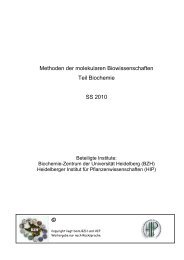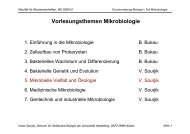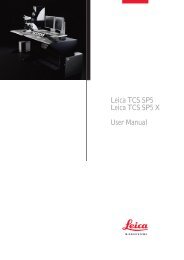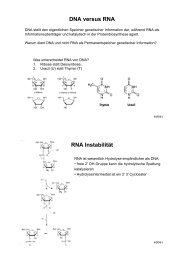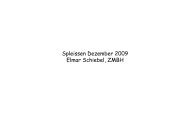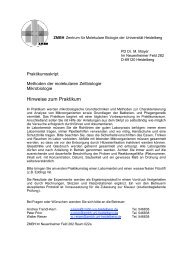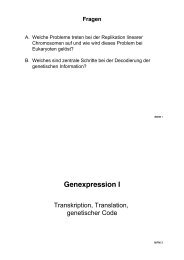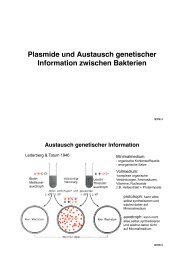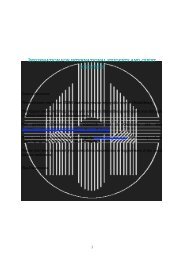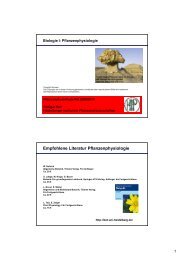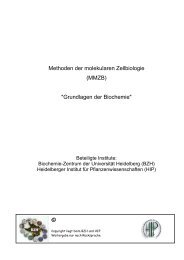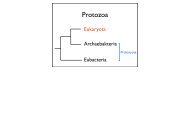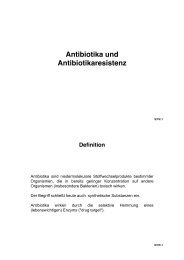ZMBH J.Bericht 2000 - Zentrum für Molekulare Biologie der ...
ZMBH J.Bericht 2000 - Zentrum für Molekulare Biologie der ...
ZMBH J.Bericht 2000 - Zentrum für Molekulare Biologie der ...
You also want an ePaper? Increase the reach of your titles
YUMPU automatically turns print PDFs into web optimized ePapers that Google loves.
Then, A. R., Berger, J., Schwarz, H., and Mayinger, P.<br />
(<strong>2000</strong>). Sac1p regulates yeast cell wall organization in<br />
a signaling pathway that is functionally related to the<br />
Slt2p MAP kinase cascade. (in press).<br />
THESES<br />
Diploma<br />
Grimm, O. (1999). Isolation and partial characterization<br />
of proteins interacting with SRP-receptor.<br />
Schlecker, T. (1999). Einfluß <strong>der</strong> intrazellulären Lokalisation<br />
von Sac1p auf die Regulation des mikro–<br />
somalen ATP-Transports.<br />
Dissertations<br />
Gruß, O. (1998). Regulation <strong>der</strong> Translokation neusyn–<br />
thetisierter Polypeptide über die Membran des rauhen<br />
endoplasmatischen Retikulums.<br />
Then, A. (1999). Identifizierung von Faktoren die<br />
funktionell mit dem Sac1p Protein in Saccharomyces<br />
cerevisiae interagieren.<br />
STRUCTURE OF THE GROUP<br />
E-mail: dobberstein@zmbh.uni-heidelberg.de<br />
Group lea<strong>der</strong> Dobberstein, Bernhard, Prof. Dr.<br />
Research<br />
associates Mayinger, Peter, Dr.<br />
Seedorf, Matthias, Dr.<br />
Postdoctoral<br />
fellows Barrett, Jeannie, Dr.*<br />
Hendriks, Robertus, Dr.*<br />
66<br />
Hölscher, Christina, Dr.<br />
Kipp, Bettina, Dr.*<br />
Martoglio, Bruno, Dr.*<br />
Owens, Sue, Dr.*<br />
Pool, Martin, Dr.<br />
Wang, Lin, Dr.*<br />
Ph.D. students Frey, Steffen,*<br />
Fröschke, Marc<br />
Gruß, Oliver*<br />
Konrad, Gerlinde*<br />
Then, Angela<br />
Diploma students Grimm, Oliver*<br />
Schlecker, Tanja*<br />
Techn. assistants Bach, Ute<br />
Meese, Klaus<br />
*part of the time reported<br />
Dirk Görlich<br />
Nucleocytoplasmic Transport<br />
The need for nuclear transport<br />
The nuclear envelope (NE) divides eukaryotic cells<br />
into a nuclear and a cytoplasmic compartment and<br />
thereby necessitates exchange between nucleus and<br />
cytoplasm. Not only must all nuclear proteins, such as<br />
histones and transcription factors, be imported from<br />
the cytoplasm, but also, tRNA, rRNA and mRNA are<br />
synthesised by transcription in the nucleus and need to<br />
be exported to the cytoplasm where they function in<br />
translation. Nuclear-cytoplasmic transport constitutes<br />
a tremendous activity that requires consi<strong>der</strong>able cellular<br />
resources and involves probably > 100 different<br />
and often very abundant proteins. However, these<br />
expenses pay off as indicated by the fact that only<br />
eukaryotes evolved into complex multicellular organisms.<br />
One can think of several reasons why a cell<br />
nucleus is required for such cellular complexity. First,<br />
the containment of the genome in a specialised organelle<br />
certainly improves genetic stability and allows<br />
eukaryotes to handle more genetic information than<br />
prokaryotes. Second, this compartmentation permits<br />
key cellular events to be regulated at a level that<br />
is unavailable to prokaryotes, e.g. by controlling the<br />
access of transcriptional regulators to chromatin. A<br />
further reason is the composition of typical eukaryotic<br />
genes from exons and introns, which requires primary<br />
transcripts to be spliced before translation may occur.<br />
Translation of unspliced pre-mRNAs would produce<br />
proteins that are not only non-functional but which<br />
may potentially act as dominant-negative inhibitors.<br />
The confinement of transcription and translation to<br />
distinct compartments can therefore be consi<strong>der</strong>ed a<br />
good solution to avoid this problem.<br />
Importin beta-like transport receptors<br />
P. Schwarzmaier, U. Kutay, G. Lipowsky, F. Paraskeva,<br />
S. Jäckel, K. Ribbeck, K. Dean, in collaboration<br />
with E. Hartmann (Univ. Göttingen), R. Kraft and<br />
S. Kostka (MDC, Berlin)<br />
Nuclear-cytoplasmic transport proceeds through<br />
nuclear pore complexes (NPCs) which allow passive<br />
diffusion of small molecules up to 20-40kD and also<br />
active, i.e., carrier-mediated transport of macromolecules.<br />
This active transport can occur along a great<br />
variety of distinct pathways, many of which are mediated<br />
by transport receptors that are at least distantly<br />
related to importin β. Transport receptors that confer<br />
import into the nucleus are referred to as importins,<br />
while export mediators are called exportins.<br />
A major objective of our laboratory has been to obtain<br />
a detailed and comprehensive overview of the various<br />
nuclear transport pathways. To identify novel transport<br />
receptors, we have employed a biochemical approach<br />
combined with data base searches and have so far<br />
arrived at 22 mammalian members of the importin β<br />
superfamily. In the following, we will briefly summarise<br />
some of our recent insights in the mechanistic<br />
principles of transport receptor function and elaborate<br />
some nuclear transport pathways in more detail.<br />
Mechanistic principles of transport receptor<br />
function<br />
Importins or exportins are capable of mediating multiple<br />
rounds of transport, which requires them to shuttle<br />
continuously between nucleus and cytoplasm. A given<br />
transport cycle, however, can only be productive if<br />
the corresponding transport receptor carries cargo in<br />
one direction only and returns „empty“ to the original<br />
compartment. This asymmetry in the transport cycles<br />
can be explained by the RanGTP-gradient model. Ran<br />
67



